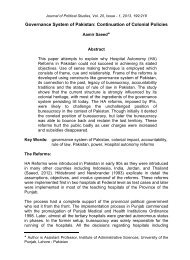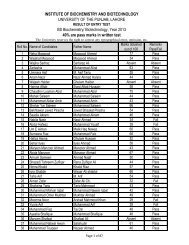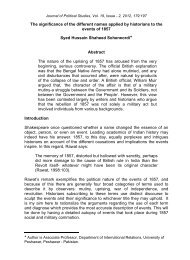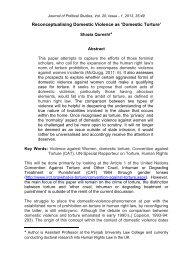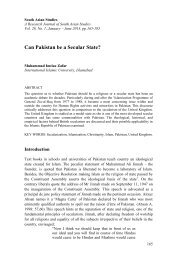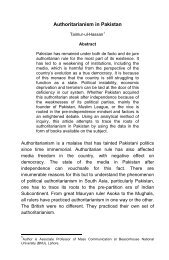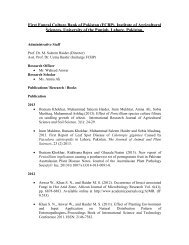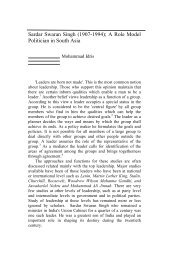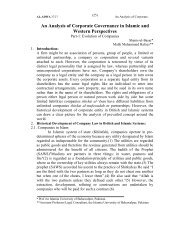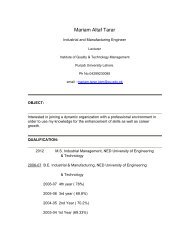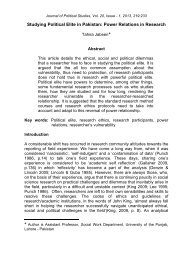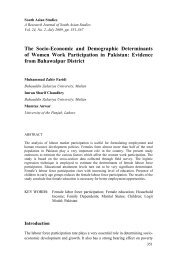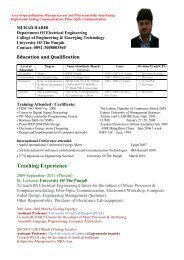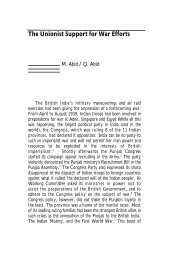pakistan geographical review 1954 - University of the Punjab
pakistan geographical review 1954 - University of the Punjab
pakistan geographical review 1954 - University of the Punjab
Create successful ePaper yourself
Turn your PDF publications into a flip-book with our unique Google optimized e-Paper software.
It realIy helped various towns to start ginning and spinning and latter on<br />
weaving. The largest cotton mill is at Shahi having 12,000 spindles. O<strong>the</strong>rs are<br />
at Yezd, Isfahan, Meshed, Bandar Abbas, Sernnaus, Kerman, Tabriz and Tehran.<br />
Total number <strong>of</strong> mills is 29. producing 4500 tons <strong>of</strong> yarn and 5. million yards<br />
<strong>of</strong> cloth annually. Textile expansion plans have been devised under which<br />
more mills will be installed at Narr afi and Sanayee. There are 9 woollen mills<br />
at Tabriz, Qazvin, Yezrl and Isfahan, where 100 tons <strong>of</strong> yarn and 150,000<br />
blankets and It million yards <strong>of</strong> cloth are prepared. In <strong>the</strong> province <strong>of</strong> Mazandran<br />
<strong>the</strong>re is silk rearing with a state owned silk factory at Chalous and a private<br />
owned at Resht, with 8,000 spindles and 224 loom. Some jute is grown on <strong>the</strong><br />
Caspian sea coast and Resht and Shahi have small jute mills.<br />
In 1947, West Pakistan had only 3 cotton weaving factories in Lahore,<br />
Okara and Lyallpur. With <strong>the</strong> growing demand for cotton cloth and limited<br />
scope for cotton export more and more weaving mills are going to be established.<br />
Four new mills have already been erected, two in Karachi, one in<br />
Multan and one in Lyallpur. Six more mills are planned to be started in <strong>the</strong><br />
near future. Total number <strong>of</strong> ginning and pressing mills is 322 and <strong>of</strong> spinning<br />
and weaving factories 21. Artificial silk is imported and at Karachi <strong>the</strong>re have<br />
been installed three silk textile mills. There is much scope for fur<strong>the</strong>r<br />
expansion in cotton as well as woollen textiles.<br />
In Iraq a cotton spinning and weaving mill was started in 1947, near<br />
Baghdad with a plan <strong>of</strong> 5,000 spindles and 84 automatic looms. A second<br />
scheme enlarged <strong>the</strong> capacity <strong>of</strong> <strong>the</strong> mill to 22,000 spindles and 500 looms.<br />
There is every liklihood <strong>of</strong> <strong>the</strong> mill producing 6,000,000 lbs. <strong>of</strong> yarn annually.<br />
Ano<strong>the</strong>r factory is being built at Mosul with 584 looms which will produce 15<br />
millions square yards <strong>of</strong> cotton and rayon cloth per year. This amount is i <strong>of</strong><br />
Iraq's normal annual requirements. Improvements in texture is being sought.<br />
Fine shirting and poplin will be-produced' and in a few years <strong>the</strong> capacity<br />
<strong>of</strong> <strong>the</strong> mill will be doubled.<br />
The woollen industry III Iraq is older than <strong>the</strong> cotton industry but<br />
so far only yarn is being spun for use in hand loom weaving and knitting. This<br />
plant is equipped to make a broad range <strong>of</strong> five fabrics. There are smaller<br />
mills capable <strong>of</strong> meeting all <strong>the</strong> requirements <strong>of</strong> <strong>the</strong> country but <strong>the</strong> present<br />
production is 50,000 kilos <strong>of</strong> yarn. It prepares 500,000 meters <strong>of</strong> cloth.<br />
Under <strong>the</strong> Ottoman rule, Syria, was <strong>the</strong> most industrialised region <strong>of</strong><br />
<strong>the</strong> Middle East. Today it is an important centre <strong>of</strong> handicraft industry.<br />
41



